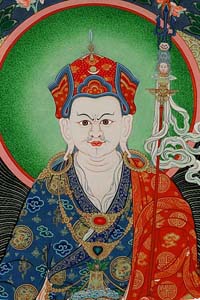
Text
Meanings
1) The Common
Hidden meaning according to:
2) The path of liberation
3) The perfection stage
4) Nyingthig of Dzogpa Chenpo
5) The accomplishment of the result
 |
||||||||||||||
|
2) The path of liberation / Commentary The Utterance of the Seed Syllable The prayer begins with the utterance of the seed syllable of the mind, HŪṂ , which awakens the self-arisen primordial wisdom, the true nature of samsāra and nirvāṇa. The Objects of the Prayer
The Prayer
The Mantra for Invoking Blessing The primordial wisdom is the emptiness essence (ngo bo stong pa), the dharmakāya, and since it is not inferior to any conceivable characteristic, it is the supreme one, the GURU. The primordial wisdom’s nature is luminescence (rang bzhin gsal ba). It is spontaneously accomplished sambhogakāya, with a ceaseless display of power. Yet it is not separate from the ultimate sphere. So it is PADMA, the lotus, which means not stained by relative characteristics. The inseparability of that essence and nature4 is the universal compassion, which arises in the samsāric and nirvāṇic display (rol pa), fulfilling the wishes of all the endless beings, which is SIDDHI or attainment. HŪṂ signifies the self-arisen primordial wisdom, the seed syllable of mind, possessor of five primordial wisdoms.
1Primordial wisdom of the ultimate sphere, mirror like primordial wisdom, primordial wisdom of evenness, discriminating primordial wisdom, and all-accomplished primordial wisdom. 2ngo bo is translated here as “essence” Generally, ngo bo, thig le of light, and thig le (semen) of physical body all could be translated as “essence,” and it is therefore confusing. So in this text I am translating the ngo bo as “essence,” thig le of physical body in the perfection stage as “essence,” and the thig le of light of Thod rgal as “thig-le.” 3“May I realize” is the significance of “Please come” in the prayer. Being a quotation from Pramāṇavārttika in Mipham Rinpoche’s text, shegs (“to come”) has the meaning of “realization” (rtogs). 4The inseparability of ngo bo and rang bzhin, stong pa and gsal ba, chos sku and longs sku, Guru and Padma. |